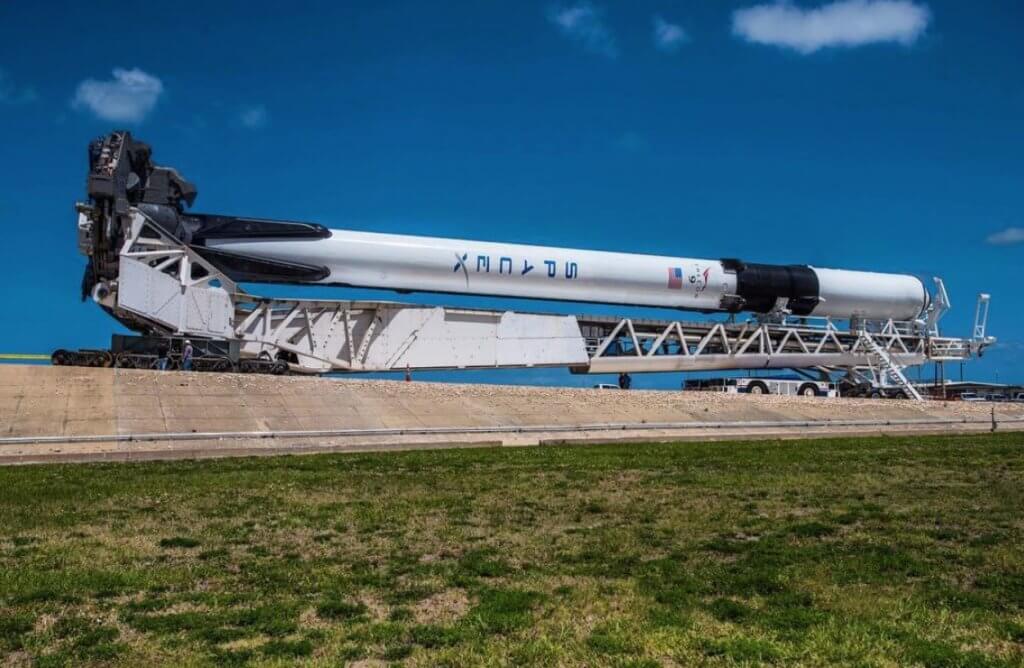Independent analyses have shown that reusable launch vehicle elements have to be capable of reuse ten times, with minimal refurbishment, to make the economics of launch reusability work. While SpaceX had shown the technical feasibility of recovery and reuse of reusable first stages, the original Block 3 and Block 4 versions of the Falcon 9 were only really capable of a single relaunch.
The firm realised that it needed to modify these stages to get to the magical ten-launch figure. And so, via a series of modifications, the Block 5 version of the Falcon 9 made its first flight at 2014 GMT on 11 May 2018 from the former Space Shuttle pad LC-39A at the Kennedy Space Center. The launch was successful to the relief of SpaceX employees. The rocket had suffered a computer-initiated abort 58 seconds before lift-off the day before.
Aboard was the Dual band Ku- and C-band communications satellite from Bangladesh, Bangabandhu-1. Built by Thales Alenia Space using its Spacebus 4000B2 design, the 3.5 metric ton spacecraft was injected into its 35549 x 309km orbit at 19.3 degrees inclination, which was only slightly shy of the planned 35706 x 300km, 19.3 degree inclination geosynchronous transfer orbit (GTO). After orbital circularisation, the satellite will use the 119.1 degrees East position in geostationary orbit, leased from the international Intersputnik organisation of Moscow for a 15-year term costing US$27.5 million.
The first stage of the Falcon 9 made a successful landing on the recovery drone ship “Of Course I Still Love You” 8 minutes and 10 seconds after launch. The stage is expected to make at least nine more flights.
As well as launching unmanned spacecraft, the Falcon 9 Block 5 is designed for human missions as the launch vehicle designated to carry commercial human missions under NASA sponsorship. But some faults on the rocket had to be fixed first. These included modifications to the tank to stop pooling of frozen oxygen and friction, which caused an on-pad explosion in 2016. In addition, the manufacturing process for the turbine in the Merlin engine turbo-pump has been changed to avoid cracking. The Block 5 version also has more system redundancy.
However, the main thrust of the changes – if you excuse the pun – is to make reusability easier to achieve with more robust structures and systems, allowing a faster turnaround.
The changes are most visually evident in the new black livery of the inter-stage – the new thermal protection material does not need paint. The rear skin is made of a water-cooled high-temperature titanium structure instead of a composite one. The rear of the first stage now has the Octaweb structure holding the engines bolted onto the rest of the stage instead of being welded on. The structure also uses a high-strength grade of aluminium with internal thermal protection in case of engine fire.
The landing legs sport an internal locking system, as opposed to the previous external one, which makes post-launch processing easier. The high-temperature Titanium guide vanes had already been changed from aluminium.
Compared with the Block 4 standard, the new Block 5 launch vehicle incorporates an even higher thrust version of the Merlin 1D engine, with an 8 per cent increase in sea level thrust that further improves the world-record-breaking thrust to weight ratio of the engine. Increased thrust was required to cope with heavier components and the increased thermal protection.
Musk has noted that SpaceX regards this Block 5 version as the final definitive Falcon 9. The firm intends to attempt a 24-hour stage turnaround next year and expects to launch the Falcon 9 Block 5 some 300 times before operations are fully transitioned to the BFR launch vehicle series – the next generation of fully reusable vehicles from SpaceX.

New Block 5 version of Falcon 9 lifts off the pad. Courtesy: SpaceX

On its transporter: Block 5 version of Falcon 9 clearly shows its black new interstage. Courtesy: SpaceX






